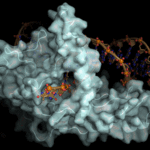The National Institutes of Health (NIH) has awarded $9.3 million to Berkeley Lab to support ongoing development of PHENIX, a software suite for solving three-dimensional macromolecular structures. Officially launched in 2000, the project is a collaboration among researchers based at Berkeley Lab, Los Alamos National Laboratory, Cambridge University, and Duke University. “The impetus behind PHENIX is a desire to make the computational aspects of crystallography more automated, reducing human error and speeding solutions,” said PHENIX principal investigator Paul Adams, director of Berkeley Lab’s Molecular Biophysics and Integrated Bioimaging Division (MBIB). Read more from the Berkeley Lab News Center.
DARPA Awards $21.6M to Develop Optogenetic ‘Read-Write’ Neural Interface
Ehud Isacoff of the Molecular Biophysics and Integrated Bioimaging (MBIB) Division is the project lead on a $21.6 million grant awarded to UC Berkeley as part of the Defense Advanced Research Projects Agency’s (DARPA’s) Neural Engineering System Design program. The team led by Isacoff, director of the Helen Wills Neuroscience Institute at UC Berkeley, aims to develop a novel brain-machine interface that uses light to monitor and modulate the activity of thousands to millions of individual neurons in the cerebral cortex.
Novel Orange Carotenoid Proteins Shed Light on Evolution of Cyanobacteria Photoprotection
Research led by Cheryl Kerfeld, with members of her group in Berkeley Lab Biosciences’ Molecular Biophysics and Integrated Bioimaging (MBIB) Division, as well as her MSU-DOE Plant Research group at Michigan State University, has identified and characterized a new, functionally distinct member of the Orange Carotenoid Protein (OCP) family. The OCP complex enables chromatically acclimating blue-green algae to avoid cellular damage and growth inhibition in conditions of high light or nutrient stress.
New Algorithms Extract Biological Structure from Limited Data
A cross-disciplinary effort by Berkeley Lab scientists has yielded a new algorithmic approach for determining 3D molecular structures from single-particle X-ray free-electron laser (XFEL) imaging. Peter Zwart of the Molecular Biophysics & Integrated Bioimaging Division (MBIB) worked with James Sethian and Jeffrey Donatelli of the Computational Research Division’s Mathematics Group to create the multi-tiered iterative phasing (M-TIP) framework, which uses advanced mathematical techniques to extract nano-scale biological structures from sparse and noisy diffraction data. A paper detailing the approach was published in the Proceedings of the National Academy of Sciences.
Researchers ID New Mechanism for Keeping DNA Protein in Line
Using a combination of crystallographic, biochemical, and genetic analyses, Berkeley Lab researchers have shown that the actions of FEN1, an enzyme involved in DNA replication and repair, are guided by electrostatic forces known as phosphate steering. Susan Tsutakawa and John Tainer in the Biosciences Area’s Molecular Biophysics and Integrated Bioimaging (MBIB) Division were the lead and corresponding authors, respectively, on the report published this week in Nature Communications. The work reveals key details of this previously unknown mechanism controlling the specificity of FEN1 in healthy cells and provides new directions for cancer treatment research. Read more from the Berkeley Lab News Center.
- « Previous Page
- 1
- …
- 52
- 53
- 54
- 55
- 56
- …
- 78
- Next Page »
Was this page useful?








